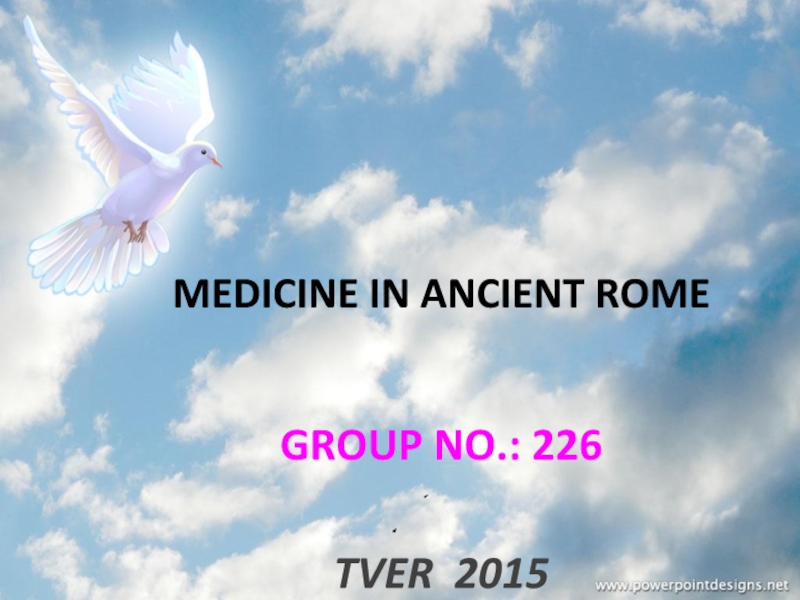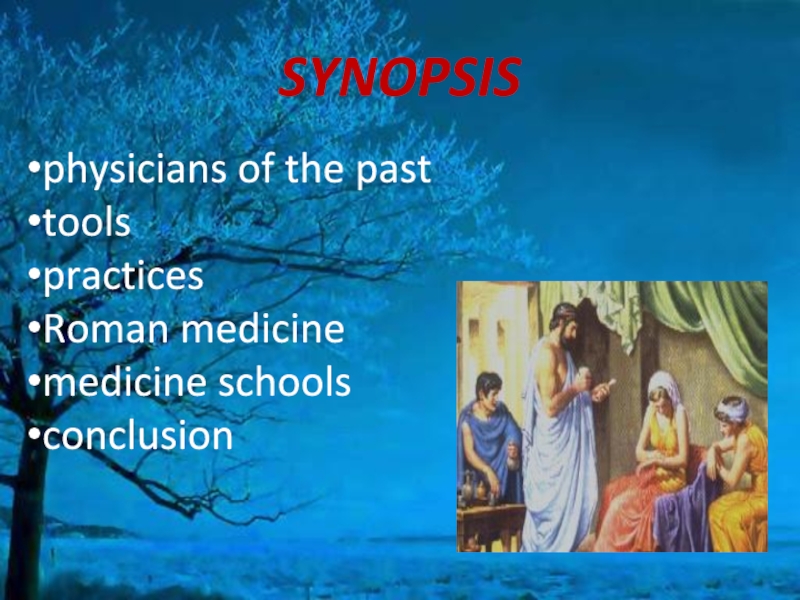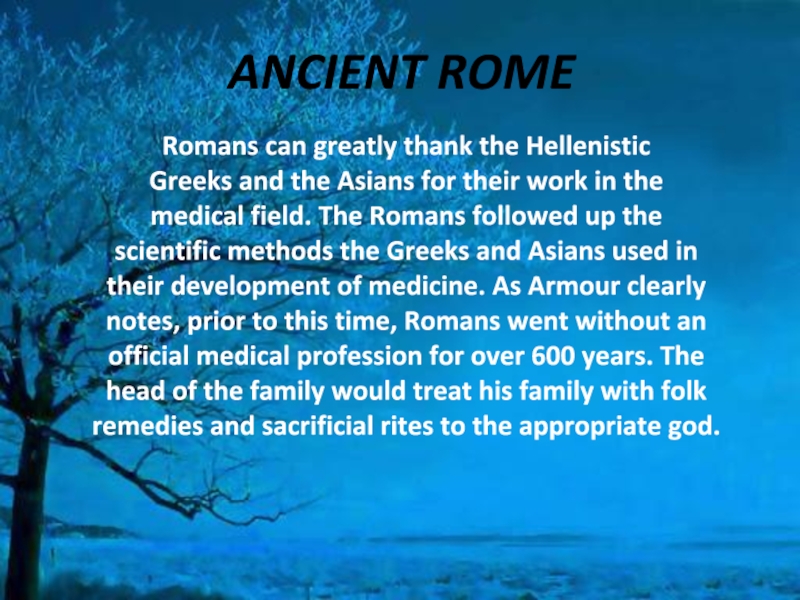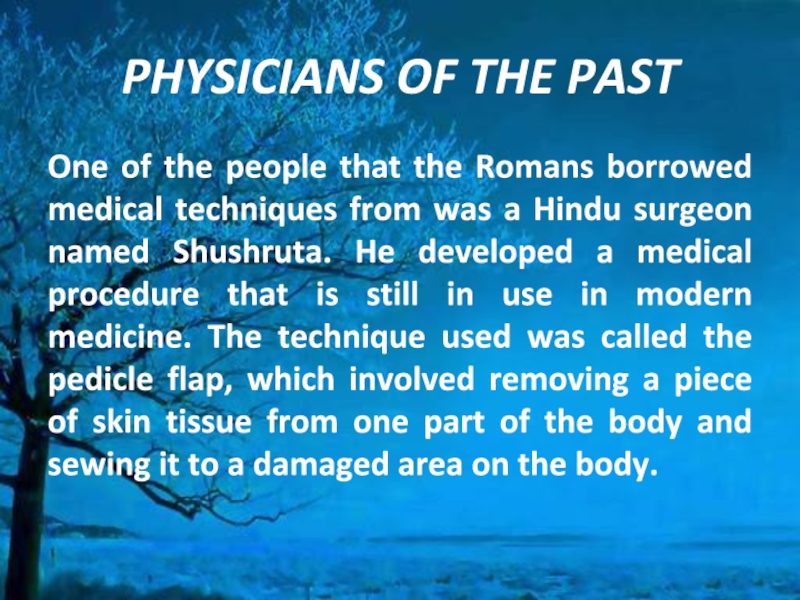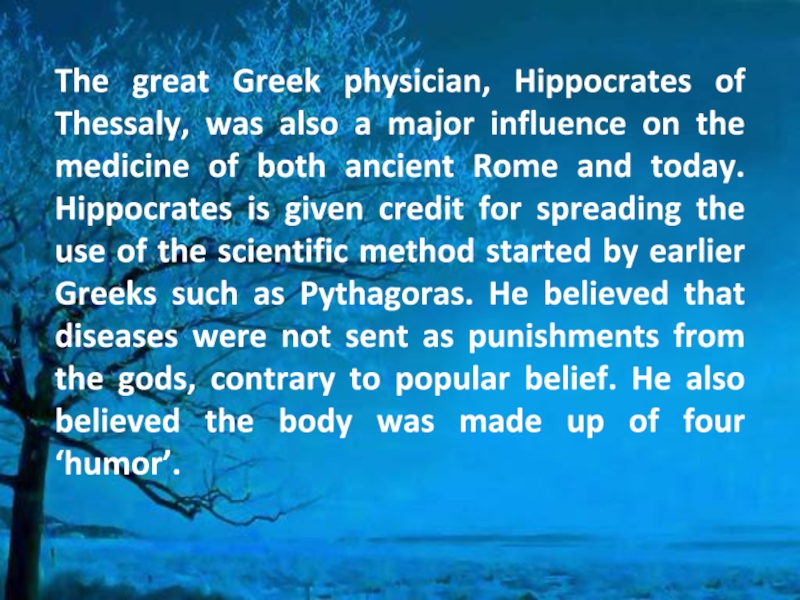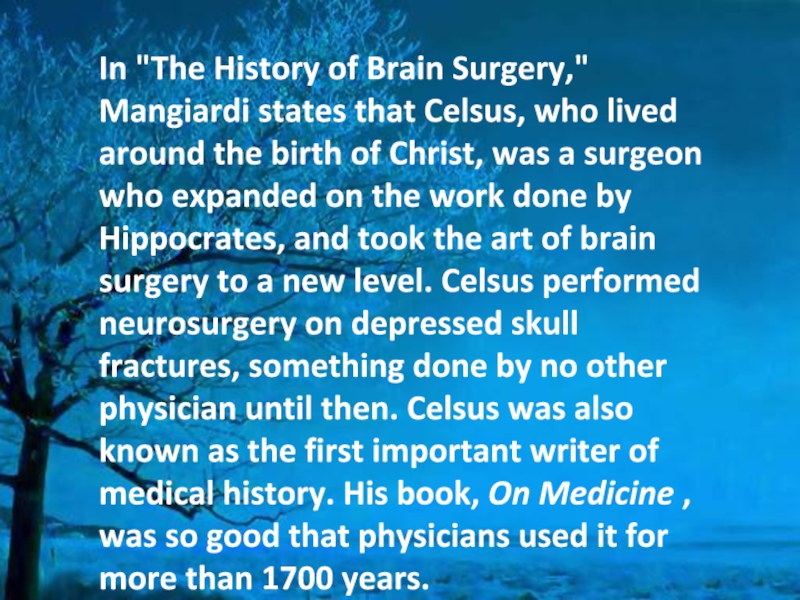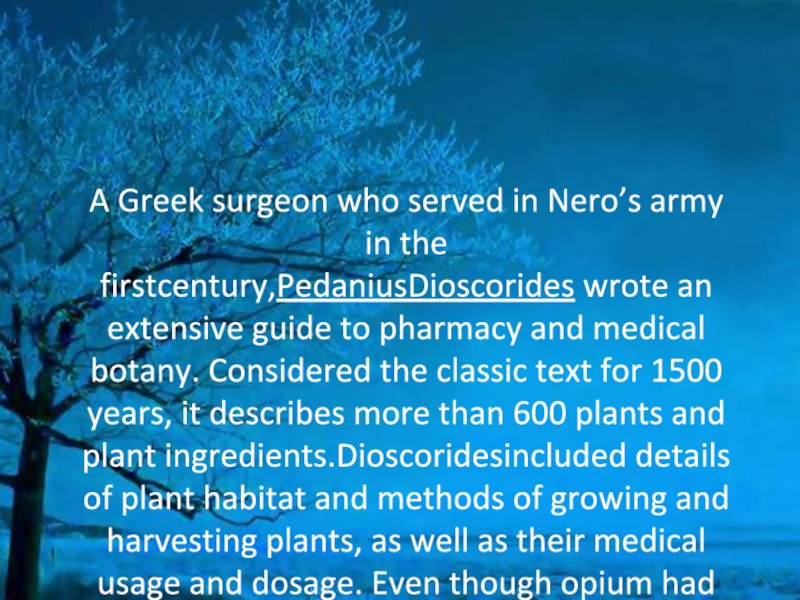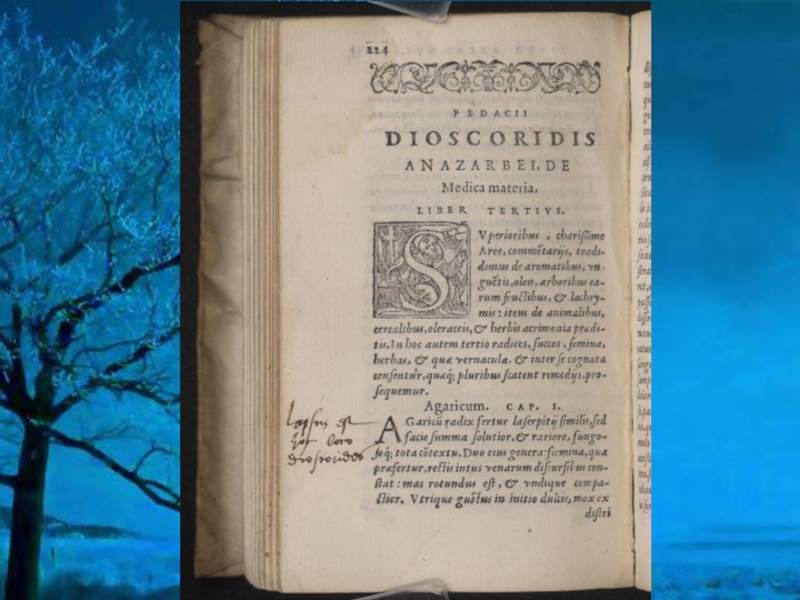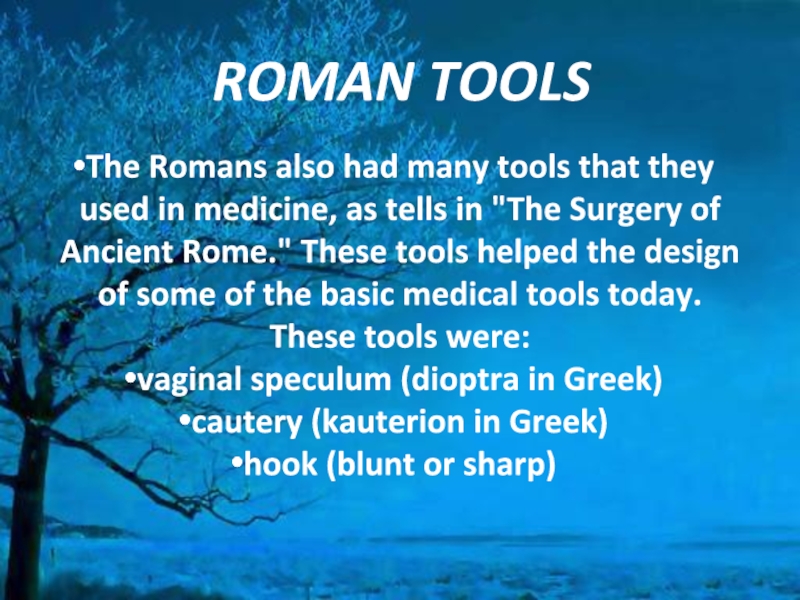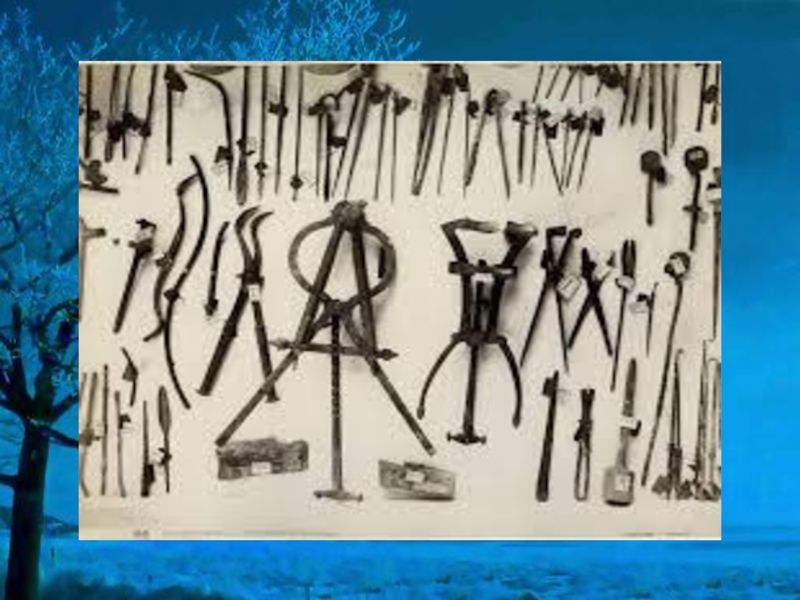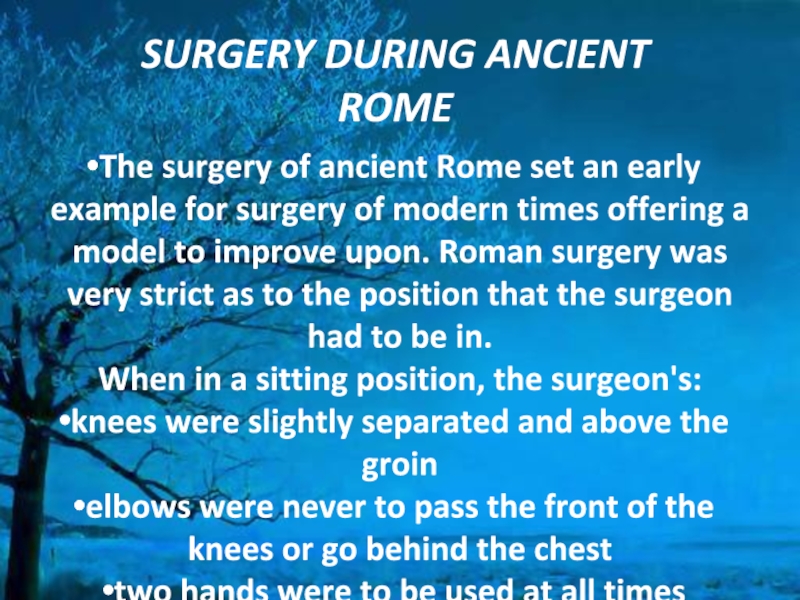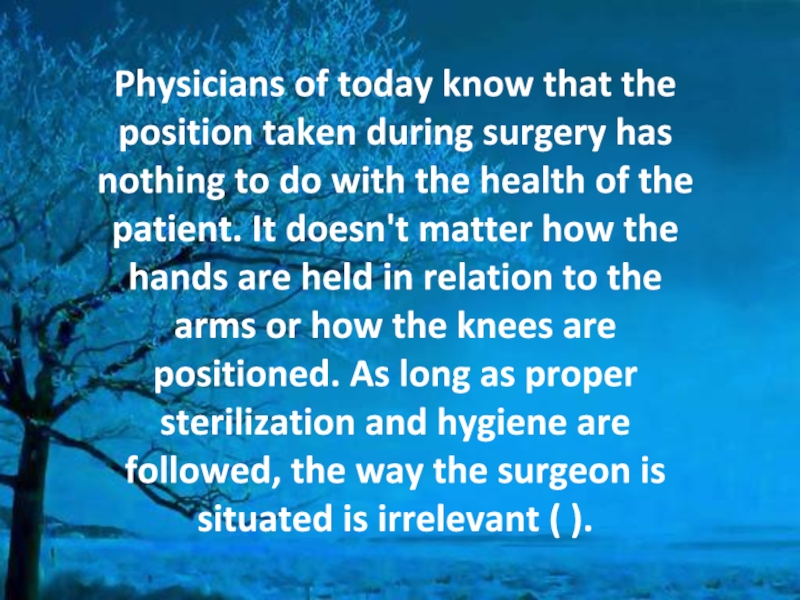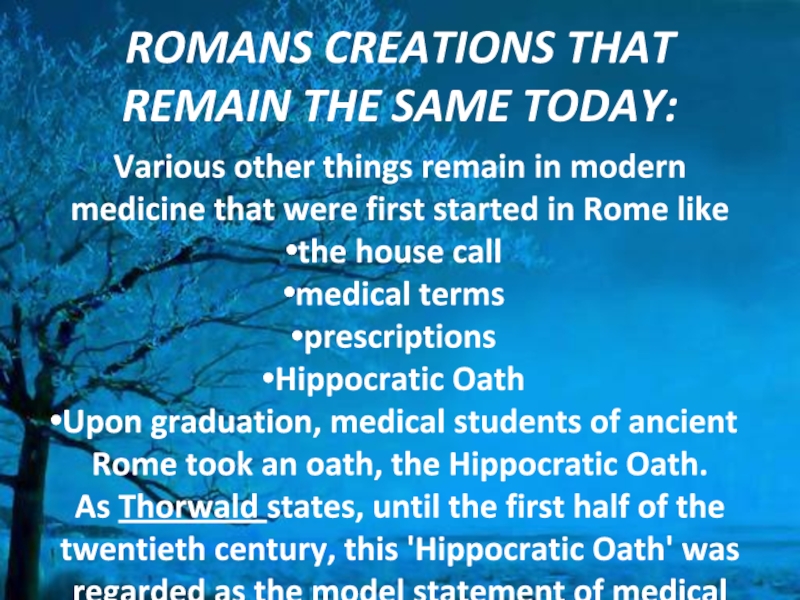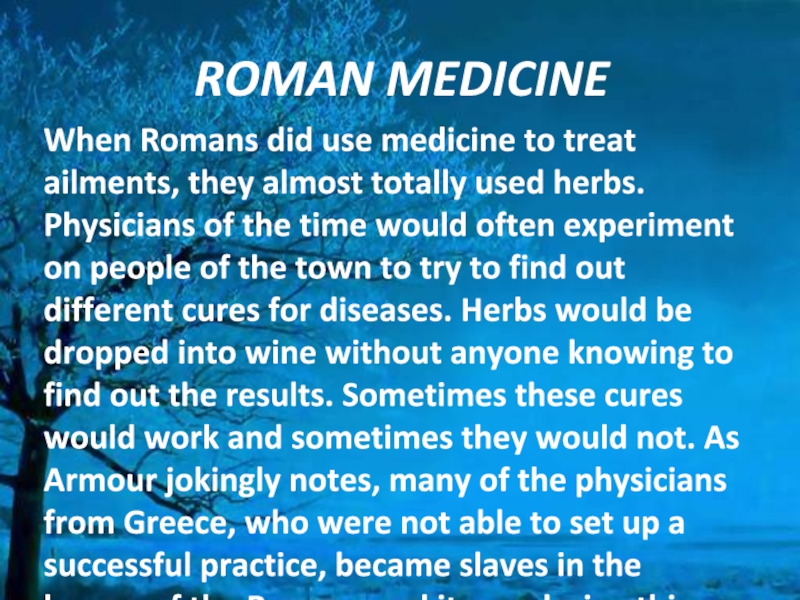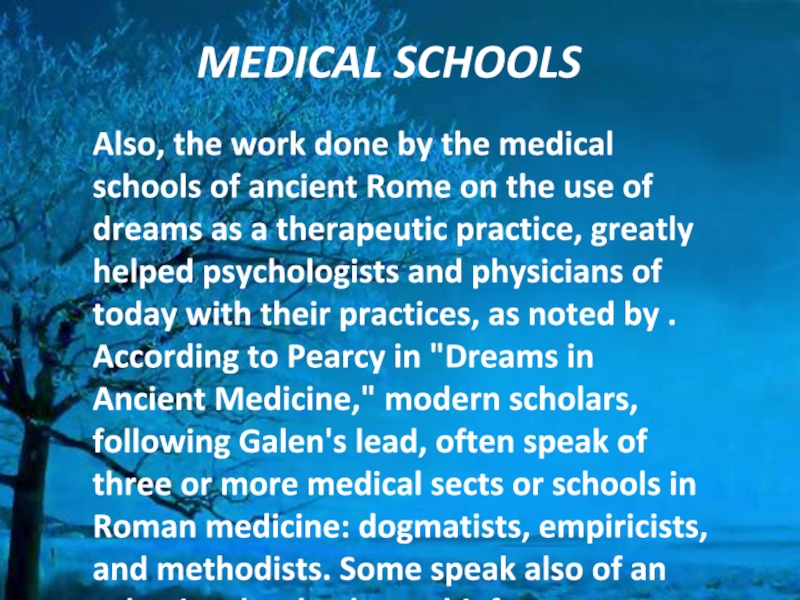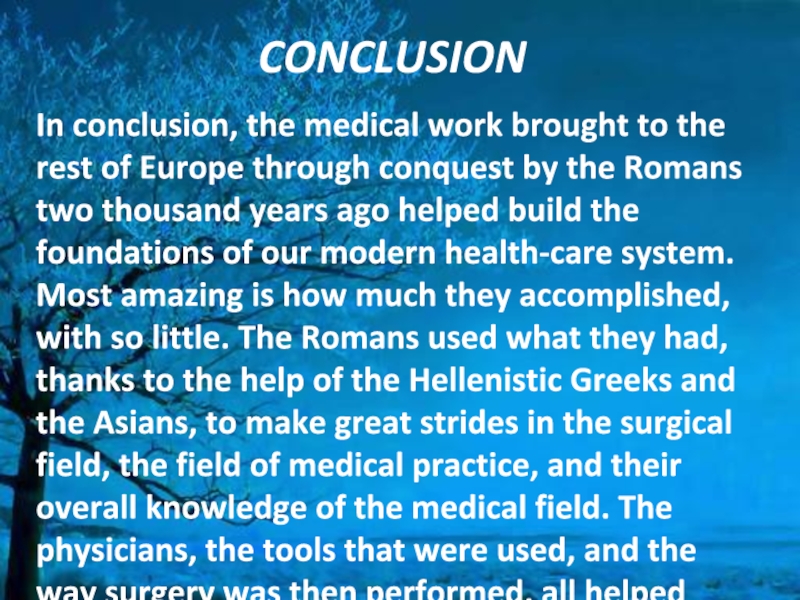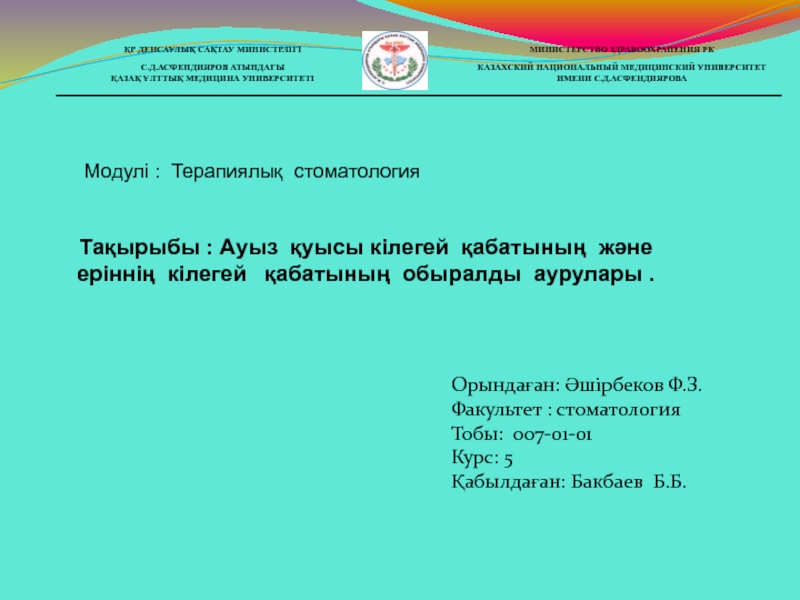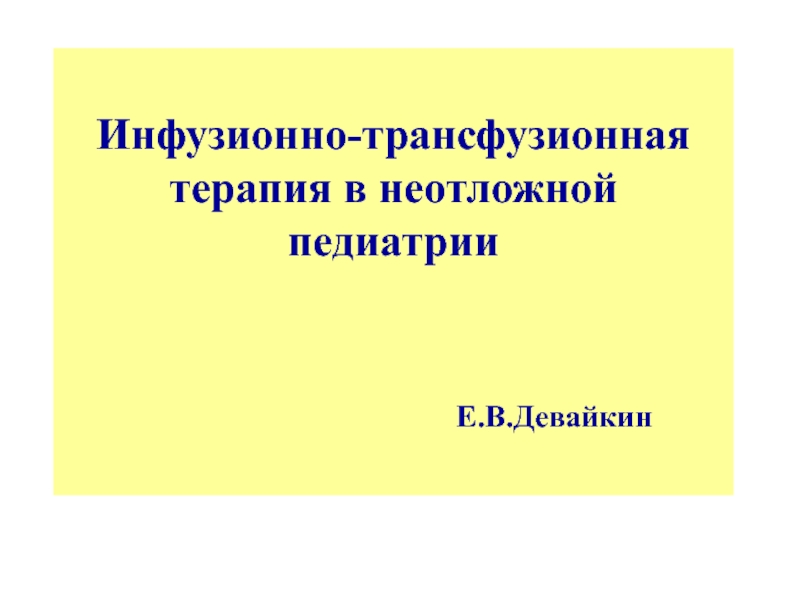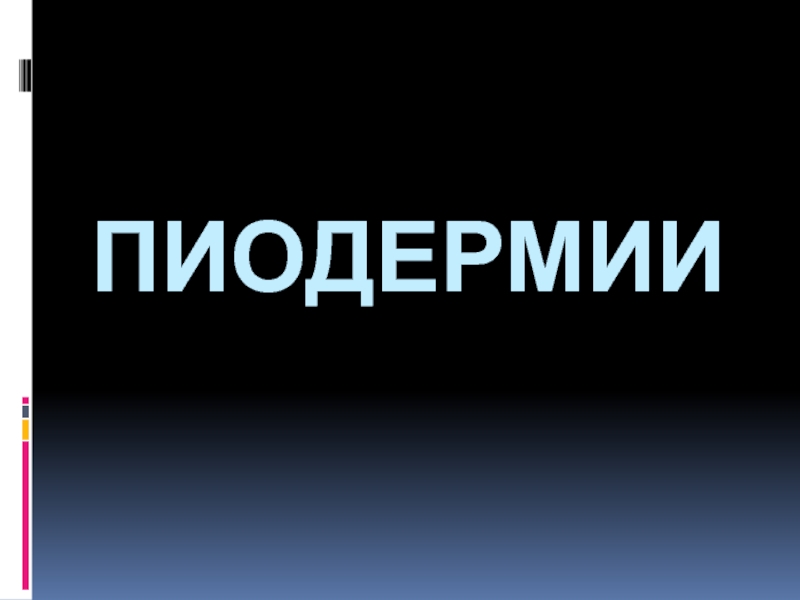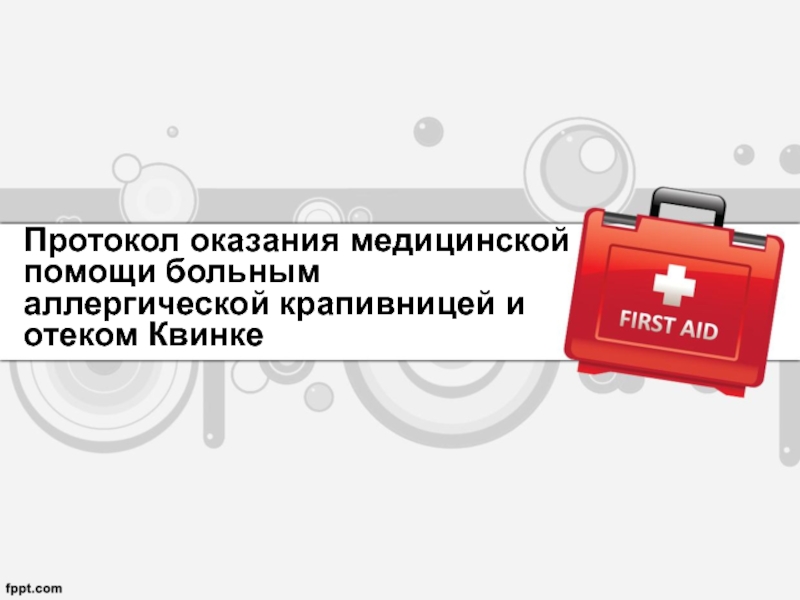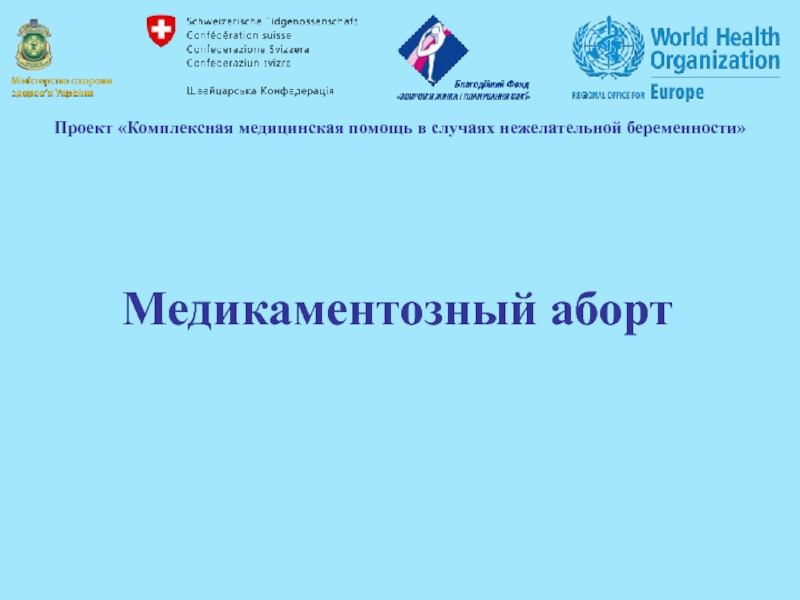- Главная
- Разное
- Дизайн
- Бизнес и предпринимательство
- Аналитика
- Образование
- Развлечения
- Красота и здоровье
- Финансы
- Государство
- Путешествия
- Спорт
- Недвижимость
- Армия
- Графика
- Культурология
- Еда и кулинария
- Лингвистика
- Английский язык
- Астрономия
- Алгебра
- Биология
- География
- Детские презентации
- Информатика
- История
- Литература
- Маркетинг
- Математика
- Медицина
- Менеджмент
- Музыка
- МХК
- Немецкий язык
- ОБЖ
- Обществознание
- Окружающий мир
- Педагогика
- Русский язык
- Технология
- Физика
- Философия
- Химия
- Шаблоны, картинки для презентаций
- Экология
- Экономика
- Юриспруденция
Medicine in Ancient Rome презентация
Содержание
- 1. Medicine in Ancient Rome
- 2. MEDICINE IN ANCIENT ROME
- 3. SYNOPSIS physicians of the past tools practices Roman medicine medicine schools conclusion
- 4. ANCIENT ROME Romans can greatly thank the
- 6. PHYSICIANS OF THE PAST One of the
- 7. The great Greek physician, Hippocrates of Thessaly,
- 8. In "The History of Brain Surgery," Mangiardi
- 9. A Greek surgeon who served in
- 11. ROMAN TOOLS The Romans also had many
- 13. SURGERY DURING ANCIENT ROME The surgery of
- 14. Physicians of today know that the position
- 16. ROMANS CREATIONS THAT REMAIN THE SAME TODAY:
- 17. ROMAN MEDICINE When Romans did use medicine
- 18. MEDICAL SCHOOLS Also, the work done by
- 19. CONCLUSION In conclusion, the medical work brought
- 20. THANK YOU
Слайд 4ANCIENT ROME
Romans can greatly thank the Hellenistic
Greeks and the Asians for
their work in the
medical field. The Romans followed up the
scientific methods the Greeks and Asians used in
their development of medicine. As Armour clearly
notes, prior to this time, Romans went without an
official medical profession for over 600 years. The
head of the family would treat his family with folk remedies and sacrificial rites to the appropriate god.
medical field. The Romans followed up the
scientific methods the Greeks and Asians used in
their development of medicine. As Armour clearly
notes, prior to this time, Romans went without an
official medical profession for over 600 years. The
head of the family would treat his family with folk remedies and sacrificial rites to the appropriate god.
Слайд 6PHYSICIANS OF THE PAST
One of the people that the Romans borrowed
medical techniques from was a Hindu surgeon named Shushruta. He developed a medical procedure that is still in use in modern medicine. The technique used was called the pedicle flap, which involved removing a piece of skin tissue from one part of the body and sewing it to a damaged area on the body.
Слайд 7The great Greek physician, Hippocrates of Thessaly, was also a major
influence on the medicine of both ancient Rome and today. Hippocrates is given credit for spreading the use of the scientific method started by earlier Greeks such as Pythagoras. He believed that diseases were not sent as punishments from the gods, contrary to popular belief. He also believed the body was made up of four ‘humor’.
Слайд 8In "The History of Brain Surgery," Mangiardi states that Celsus, who
lived around the birth of Christ, was a surgeon who expanded on the work done by Hippocrates, and took the art of brain surgery to a new level. Celsus performed neurosurgery on depressed skull fractures, something done by no other physician until then. Celsus was also known as the first important writer of medical history. His book, On Medicine , was so good that physicians used it for more than 1700 years.
Слайд 9
A Greek surgeon who served in Nero’s army in the firstcentury,PedaniusDioscorides wrote
an extensive guide to pharmacy and medical botany. Considered the classic text for 1500 years, it describes more than 600 plants and plant ingredients.Dioscoridesincluded details of plant habitat and methods of growing and harvesting plants, as well as their medical usage and dosage. Even though opium had been used for centuries,Dioscorideswas the first to describe its benefits and dangers. He also discussed mineral and animal products that were of medicinal value. His work identified plant families long beforeLinneaus’sclassification system in the eighteenth century.
Слайд 11ROMAN TOOLS
The Romans also had many tools that they used in
medicine, as tells in "The Surgery of Ancient Rome." These tools helped the design of some of the basic medical tools today.
These tools were:
vaginal speculum (dioptra in Greek)
cautery (kauterion in Greek)
hook (blunt or sharp)
These tools were:
vaginal speculum (dioptra in Greek)
cautery (kauterion in Greek)
hook (blunt or sharp)
Слайд 13SURGERY DURING ANCIENT ROME
The surgery of ancient Rome set an early
example for surgery of modern times offering a model to improve upon. Roman surgery was very strict as to the position that the surgeon had to be in.
When in a sitting position, the surgeon's:
knees were slightly separated and above the groin
elbows were never to pass the front of the knees or go behind the chest
two hands were to be used at all times
hands never were to be over the breast
forearms were to be kept at right angles to the arms
When in a sitting position, the surgeon's:
knees were slightly separated and above the groin
elbows were never to pass the front of the knees or go behind the chest
two hands were to be used at all times
hands never were to be over the breast
forearms were to be kept at right angles to the arms
Слайд 14Physicians of today know that the position taken during surgery has
nothing to do with the health of the patient. It doesn't matter how the hands are held in relation to the arms or how the knees are positioned. As long as proper sterilization and hygiene are followed, the way the surgeon is situated is irrelevant ( ).
Слайд 16ROMANS CREATIONS THAT REMAIN THE SAME TODAY:
Various other things remain in
modern medicine that were first started in Rome like
the house call
medical terms
prescriptions
Hippocratic Oath
Upon graduation, medical students of ancient Rome took an oath, the Hippocratic Oath. As Thorwald states, until the first half of the twentieth century, this 'Hippocratic Oath' was regarded as the model statement of medical ethics (219).
the house call
medical terms
prescriptions
Hippocratic Oath
Upon graduation, medical students of ancient Rome took an oath, the Hippocratic Oath. As Thorwald states, until the first half of the twentieth century, this 'Hippocratic Oath' was regarded as the model statement of medical ethics (219).
Слайд 17ROMAN MEDICINE
When Romans did use medicine to treat ailments, they almost
totally used herbs. Physicians of the time would often experiment on people of the town to try to find out different cures for diseases. Herbs would be dropped into wine without anyone knowing to find out the results. Sometimes these cures would work and sometimes they would not. As Armour jokingly notes, many of the physicians from Greece, who were not able to set up a successful practice, became slaves in the homes of the Romans and it was during this period that the phrase "Beware of Greeks bearing drugs" came about ( ).
Слайд 18MEDICAL SCHOOLS
Also, the work done by the medical schools of ancient
Rome on the use of dreams as a therapeutic practice, greatly helped psychologists and physicians of today with their practices, as noted by . According to Pearcy in "Dreams in Ancient Medicine," modern scholars, following Galen's lead, often speak of three or more medical sects or schools in Roman medicine: dogmatists, empiricists, and methodists. Some speak also of an eclectic school, whose chief representative is Galen himself.
Слайд 19CONCLUSION
In conclusion, the medical work brought to the rest of Europe
through conquest by the Romans two thousand years ago helped build the foundations of our modern health-care system. Most amazing is how much they accomplished, with so little. The Romans used what they had, thanks to the help of the Hellenistic Greeks and the Asians, to make great strides in the surgical field, the field of medical practice, and their overall knowledge of the medical field. The physicians, the tools that were used, and the way surgery was then performed, all helped create building blocks of modern medicine. Without the conquest of Europe by the Ancient Romans, we might not be as technologically advanced as we are today in the medical field.
